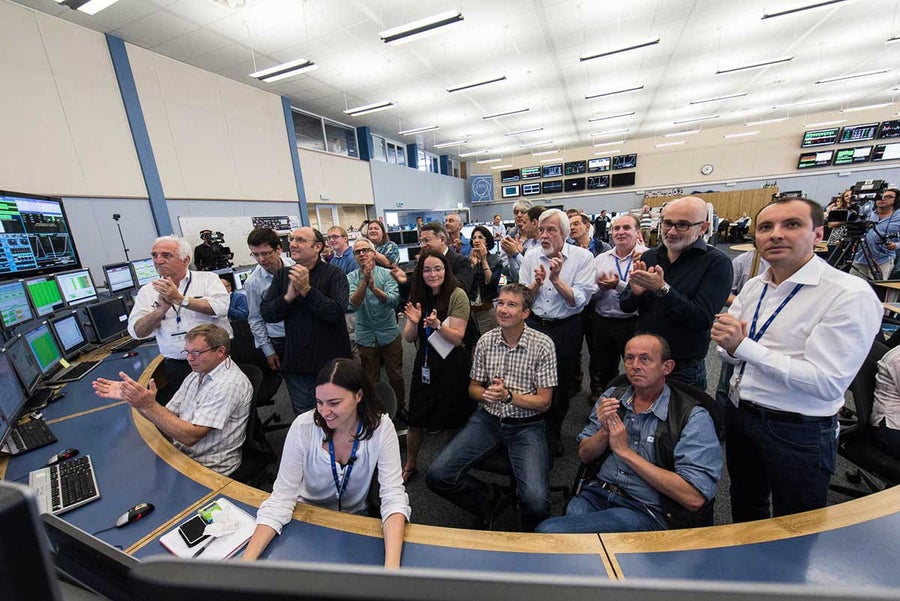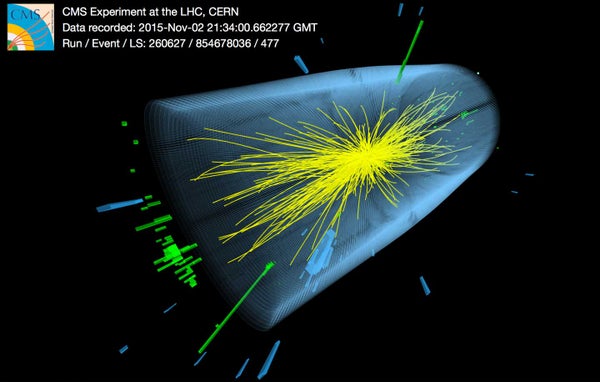A little wiggle on a graph, representing just a handful of particles, has set the world of physics abuzz. Scientists at the Large Hadron Collider (LHC) in Switzerland, the largest particle accelerator on Earth, reported yesterday that their machine might have produced a brand new particle not included in the established laws of particle physics known as the Standard Model. Their results, based on the data collected from April to November after the LHC began colliding protons at nearly twice the energy of its previous runs, are too inconclusive to be sure—many physicists warned that the wiggle could just as easily represent a statistical fluke. Nevertheless, the finding has already spawned at least 10 new papers in less than a day proposing a theoretical explanation for the particle, and has the halls and blackboards of physics departments around the world churning.
“This is something that we’ve been waiting for for a long time,” says Adam Falkowski, a physicist at the Institute of Theoretical Physics in Warsaw and a member of the CERN Theory Group. “Of course we are aware this could be nothing. But for my generation, this is the first time there is a very large, quite reliable signal of physics beyond the Standard Model, so it’s definitely very exciting.” Of course, others echoed the usual refrain of caution: “Extraordinary claims require extraordinary evidence, and this is not that,” Columbia University physicist Peter Woit wrote on his blog.
If the LHC truly has seen a new particle, however, the question looming large is: What is it? From its signature at the LHC, the particle must weigh roughly 750 giga-electron volts (GeV), around 750 times the mass of the proton, and would fall into the class of bosons, meaning its spin has an integer value. Some theorists say the newcomer looks like a heavier cousin of the Higgs boson, which similarly first showed up at the LHC as a highly intriguing blip in the data about four years ago. Or it could be a kind of portal particle into the dark matter sector—because this particle decays almost immediately, on its own it cannot account for the invisible matter that seems to be ubiquitous in space, but it may be a messenger that communicates with the dark matter particle, theorists suggested. Another hypothetical alternative is that it is a graviton, the predicted carrier particle for the force of gravity.
On supporting science journalism
If you're enjoying this article, consider supporting our award-winning journalism by subscribing. By purchasing a subscription you are helping to ensure the future of impactful stories about the discoveries and ideas shaping our world today.
“There’s a long list of possible things it could be beyond what we already know the universe contains,” says Jim Olsen, a Princeton University physicist who presented the CMS results. “Before today there was no theory paper that predicted we would find this.” Many scientists have been hoping the LHC would manifest proof of a theory called supersymmetry, which predicts many additional “partner” particles to match the ones we already know of. The 750-GeV particle, however, would not be one of these partners. “Even if this signal turns out to be right, it does not yet obviously tell us anything about whether there is supersymmetry,” says Peter Graham, a theorist at Stanford University.

The LHC operations team looks at data readings as protons collide inside the accelerator's 27-kilometer ring.
Credit: CERN
The most striking thing about the results, scientists say, is that two experiments at the LHC—ATLAS and CMS (for Compact Muon Solenoid)—which use different setups and conduct wholly separate analyses of their independent sets of data, saw signs of roughly the same thing. “It’s a significant excess in ATLAS alone and that would be interesting by itself, however additional credence is given by the fact that two experiments see it in the same place,” Falkowski says. “It reduces the chance that it’s a random fluctuation by a large factor.” There is still cause, however, for skepticism. “If you look in a lot of places there’s a decent chance you’ll see a fluctuation in at least one place,” says Ken Bloom of the University of Nebraska-Lincoln, a member of the CMS team. “My own personal guess is that it’s most likely a fluctuation. We see relatively low-significance things like this all the time.” Physicists also say that such a particle probably should have shown up in the earlier runs at the LHC. Although those runs were operating at lower energies, they still would have been sufficient to create a particle in the 750-GeV mass range, but researchers saw only a very minor hint of anything there. Statistical flukes, however, run both ways, and perhaps those runs just happened to come up relatively empty.
The signal ATLAS saw amounted to about 10 particles more than would be expected from “background”—that is, normal particles within the standard canon—after around a billion proton collisions. CMS saw roughly three, according to plots scientists presented yesterday. Those tallies may sound meager, but the experiments are so sensitive, and have such precise predictions for the number of particles of any given mass they expect to see, that the results were statistically significant. Still, “it is not a discovery—it’s a potential discovery,” Olsen says.
Impatient physicists will not have to wait long to learn the truth. The data coming back from the LHC next year should soon either confirm or disprove the possible new particle. “I certainly hope we’ll get something interesting in the future, but we don’t know,” Bloom says. “If these results turn out to be the first hint of that, then we’ll look back on this day a few years from now and say, ‘that’s when we first started seeing things.’ I consider this something of a teaser.”
